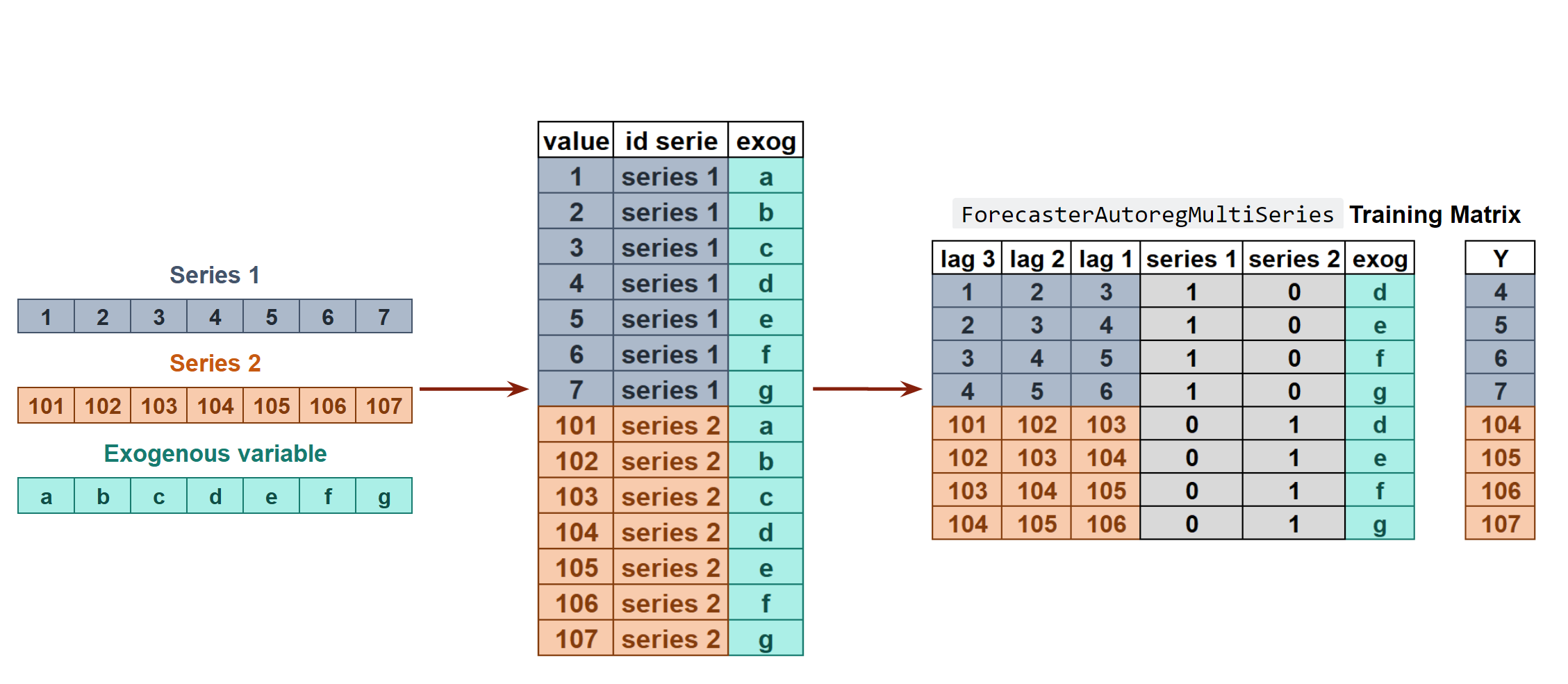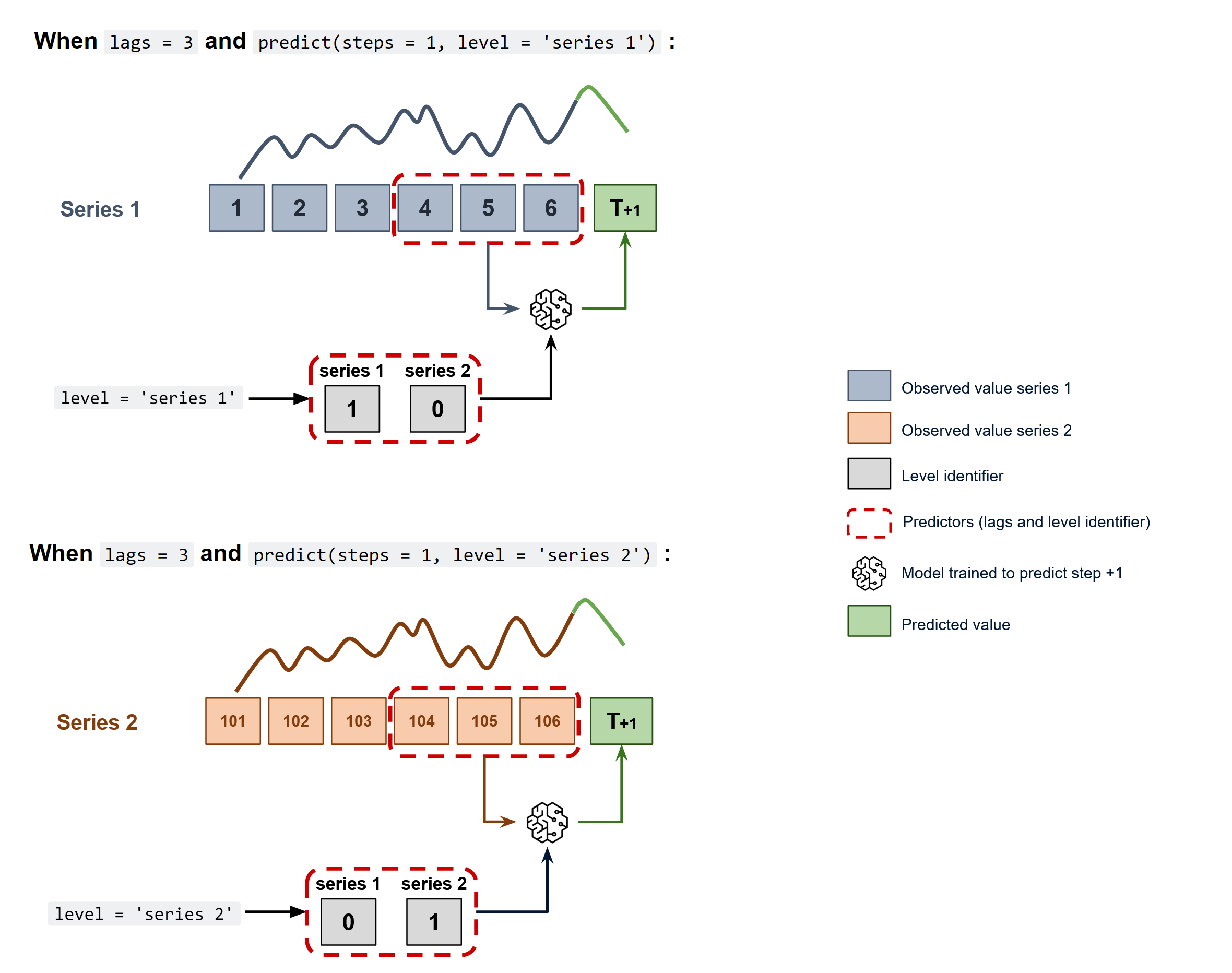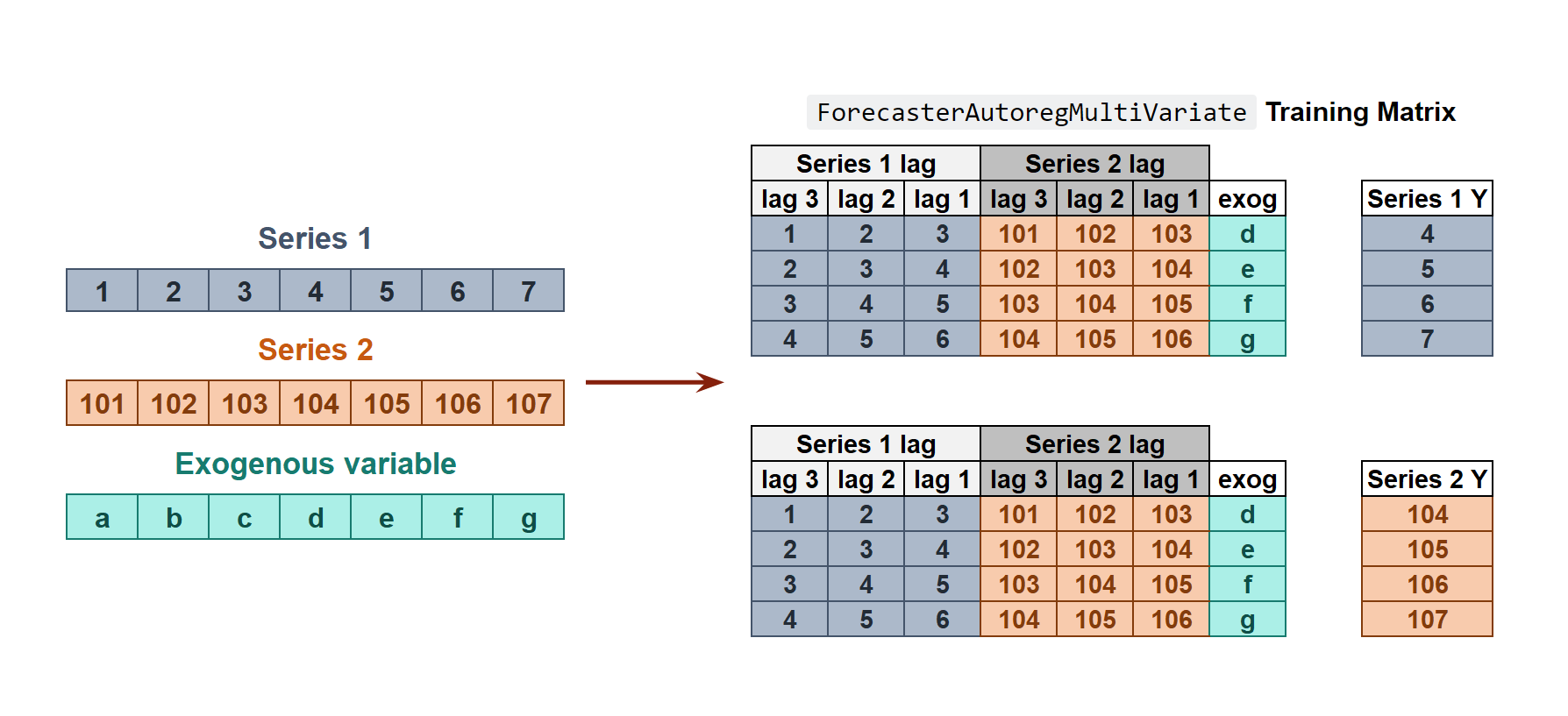Multi-series forecasting¶
In univariate time series forecasting, a single time series is modeled as a linear or nonlinear combination of its lags. That is, the past values of the series are used to forecast its future. In multi-series forecasting, two or more time series are modeled together using a single model. Two strategies can be distinguished:
No multivariate time series
A single model is trained, but each time series remains independent of the others. In other words, the past values of one series are not used as predictors of other series. Why is it useful then to model everything together? Although the series do not depend on each other, they may follow the same intrinsic pattern regarding their past and future values. For example, in the same store, the sales of products A and B may not be related, but they follow the same dynamics, that of the store.

To predict the next n steps, the same strategy of recursive multi-step forecasting is applied.

Multivariate time series
All series are modeled considering that each time series depends not only on its past values but also on the past values of the other series. The forecaster is expected not only to learn the information of each series separately but also to relate them. For example, the measurements made by all the sensors (flow, temperature, pressure...) installed on an industrial machine such as a compressor. Multivariate time series user guide.

Note
ForecasterAutoregMultiSeries class covers the use case of No Multivariate time series.
For a more detailed example visit: Multi-series forecasting
Libraries¶
# Libraries
# ==============================================================================
import numpy as np
import pandas as pd
import matplotlib.pyplot as plt
from sklearn.preprocessing import StandardScaler
from sklearn.linear_model import Ridge
from sklearn.metrics import mean_absolute_error
from skforecast.ForecasterAutoregMultiSeries import ForecasterAutoregMultiSeries
from skforecast.model_selection_multiseries import backtesting_forecaster_multiseries
from skforecast.model_selection_multiseries import grid_search_forecaster_multiseries
Data¶
# Data download
# ==============================================================================
url = ('https://raw.githubusercontent.com/JoaquinAmatRodrigo/skforecast/master/' +
'data/simulated_items_sales.csv')
data = pd.read_csv(url, sep=',')
# Data preparation
# ==============================================================================
data['date'] = pd.to_datetime(data['date'], format='%Y-%m-%d')
data = data.set_index('date')
data = data.asfreq('D')
data = data.sort_index()
data.head()
| item_1 | item_2 | item_3 | |
|---|---|---|---|
| date | |||
| 2012-01-01 | 8.253175 | 21.047727 | 19.429739 |
| 2012-01-02 | 22.777826 | 26.578125 | 28.009863 |
| 2012-01-03 | 27.549099 | 31.751042 | 32.078922 |
| 2012-01-04 | 25.895533 | 24.567708 | 27.252276 |
| 2012-01-05 | 21.379238 | 18.191667 | 20.357737 |
# Split data into train-val-test
# ==============================================================================
end_train = '2014-07-15 23:59:00'
data_train = data.loc[:end_train, :].copy()
data_test = data.loc[end_train:, :].copy()
print(f"Train dates : {data_train.index.min()} --- {data_train.index.max()} (n={len(data_train)})")
print(f"Test dates : {data_test.index.min()} --- {data_test.index.max()} (n={len(data_test)})")
Train dates : 2012-01-01 00:00:00 --- 2014-07-15 00:00:00 (n=927) Test dates : 2014-07-16 00:00:00 --- 2015-01-01 00:00:00 (n=170)
# Plot time series
# ==============================================================================
fig, axes = plt.subplots(nrows=3, ncols=1, figsize=(10, 6), sharex=True)
data_train['item_1'].plot(label='train', ax=axes[0])
data_test['item_1'].plot(label='test', ax=axes[0])
axes[0].set_xlabel('')
axes[0].set_ylabel('MW')
axes[0].set_title('Item 1')
axes[0].legend()
data_train['item_2'].plot(label='train', ax=axes[1])
data_test['item_2'].plot(label='test', ax=axes[1])
axes[1].set_xlabel('')
axes[1].set_ylabel('sales')
axes[1].set_title('Item 2')
data_train['item_3'].plot(label='train', ax=axes[2])
data_test['item_3'].plot(label='test', ax=axes[2])
axes[2].set_xlabel('')
axes[2].set_ylabel('sales')
axes[2].set_title('Item 3')
fig.tight_layout()
plt.show();
Train and predict ForecasterAutoregMultiSeries¶
# Create and fit forecaster multi series
# ==============================================================================
forecaster = ForecasterAutoregMultiSeries(
regressor = Ridge(random_state=123),
lags = 24,
transformer_series = None,
transformer_exog = None,
weight_func = None,
series_weights = None
)
forecaster.fit(series=data_train)
forecaster
============================
ForecasterAutoregMultiSeries
============================
Regressor: Ridge(random_state=123)
Lags: [ 1 2 3 4 5 6 7 8 9 10 11 12 13 14 15 16 17 18 19 20 21 22 23 24]
Transformer for series: None
Transformer for exog: None
Window size: 24
Series levels (names): ['item_1', 'item_2', 'item_3']
Series weights: None
Weight function included: False
Exogenous included: False
Type of exogenous variable: None
Exogenous variables names: None
Training range: [Timestamp('2012-01-01 00:00:00'), Timestamp('2014-07-15 00:00:00')]
Training index type: DatetimeIndex
Training index frequency: D
Regressor parameters: {'alpha': 1.0, 'copy_X': True, 'fit_intercept': True, 'max_iter': None, 'normalize': 'deprecated', 'positive': False, 'random_state': 123, 'solver': 'auto', 'tol': 0.001}
Creation date: 2022-11-29 12:33:52
Last fit date: 2022-11-29 12:33:52
Skforecast version: 0.6.0
Python version: 3.9.13
Two methods can be use to predict the next n steps: predict() or predict_interval(). The argument levels is used to indicate for which series estimate predictions. If None all series will be predicted.
# Predict and predict_interval
# ==============================================================================
steps = 24
# Predictions for item_1
predictions_item_1 = forecaster.predict(steps=steps, levels='item_1')
display(predictions_item_1.head(3))
# Interval predictions for item_1
predictions_intervals = forecaster.predict_interval(steps=steps, levels=['item_1', 'item_2'])
display(predictions_intervals.head(3))
| item_1 | |
|---|---|
| 2014-07-16 | 25.497376 |
| 2014-07-17 | 24.866972 |
| 2014-07-18 | 24.281173 |
| item_1 | item_1_lower_bound | item_1_upper_bound | item_2 | item_2_lower_bound | item_2_upper_bound | |
|---|---|---|---|---|---|---|
| 2014-07-16 | 25.497376 | 23.220087 | 28.226068 | 10.694506 | 7.093046 | 15.518896 |
| 2014-07-17 | 24.866972 | 22.141168 | 27.389805 | 11.080091 | 6.467676 | 16.534679 |
| 2014-07-18 | 24.281173 | 21.688393 | 26.981395 | 11.490882 | 7.077863 | 16.762530 |
Backtesting Multi Series¶
As in the predict method, the levels at which backtesting is performed must be indicated. The argument can also be set to None to perform backtesting at all levels.
# Backtesting Multi Series
# ==============================================================================
metrics_levels, backtest_predictions = backtesting_forecaster_multiseries(
forecaster = forecaster,
series = data,
levels = None,
steps = 24,
metric = 'mean_absolute_error',
initial_train_size = len(data_train),
refit = True,
fixed_train_size = True,
verbose = False
)
print("Backtest metrics")
display(metrics_levels)
print("")
print("Backtest predictions")
backtest_predictions.head(4)
Backtest metrics
| levels | mean_absolute_error | |
|---|---|---|
| 0 | item_1 | 1.360675 |
| 1 | item_2 | 2.332392 |
| 2 | item_3 | 3.155592 |
Backtest predictions
| item_1 | item_2 | item_3 | |
|---|---|---|---|
| 2014-07-16 | 25.497376 | 10.694506 | 11.275026 |
| 2014-07-17 | 24.866972 | 11.080091 | 11.313510 |
| 2014-07-18 | 24.281173 | 11.490882 | 13.030112 |
| 2014-07-19 | 23.515499 | 11.548922 | 13.378282 |
Hyperparameter tuning and lags selection Multi Series¶
Functions grid_search_forecaster_multiseries and random_search_forecaster_multiseries in the module model_selection_multiseries allow for lag and hyperparameter optimization. The optimization is performed in the same way as in the other forecasters, see the user guide here, except for the levels argument:
levels: level(s) at which the forecaster is optimized, for example:If
levels = ['item_1', 'item_2', 'item_3'](Same aslevels = None), the function will search for the lags and hyperparameters that minimize the average error of the predictions of all the time series. The resulting metric will be the average of all levels.If
levels = 'item_1'(Same aslevels = ['item_1']), the function will search for the lags and hyperparameters that minimize the error of theitem_1predictions. The resulting metric will be the one calculated foritem_1.
The following example shows how to use grid_search_forecaster_multiseries to find the best lags and model hyperparameters for all time series:
# Create forecaster multi series
# ==============================================================================
forecaster = ForecasterAutoregMultiSeries(
regressor = Ridge(random_state=123),
lags = 24,
transformer_series = StandardScaler(),
transformer_exog = None,
weight_func = None,
series_weights = None
)
# Grid search Multi Series
# ==============================================================================
lags_grid = [24, 48]
param_grid = {'alpha': [0.01, 0.1, 1]}
levels = ['item_1', 'item_2', 'item_3']
results = grid_search_forecaster_multiseries(
forecaster = forecaster,
series = data,
exog = None,
levels = levels,
lags_grid = lags_grid,
param_grid = param_grid,
steps = 24,
metric = 'mean_absolute_error',
initial_train_size = len(data_train),
refit = True,
fixed_train_size = True,
return_best = False,
verbose = False
)
results
6 models compared for 3 level(s). Number of iterations: 6.
loop lags_grid: 100%|███████████████████████████████████████| 2/2 [00:01<00:00, 1.34it/s]
| levels | lags | params | mean_absolute_error | alpha | |
|---|---|---|---|---|---|
| 5 | [item_1, item_2, item_3] | [1, 2, 3, 4, 5, 6, 7, 8, 9, 10, 11, 12, 13, 14... | {'alpha': 1} | 2.207648 | 1.00 |
| 4 | [item_1, item_2, item_3] | [1, 2, 3, 4, 5, 6, 7, 8, 9, 10, 11, 12, 13, 14... | {'alpha': 0.1} | 2.207700 | 0.10 |
| 3 | [item_1, item_2, item_3] | [1, 2, 3, 4, 5, 6, 7, 8, 9, 10, 11, 12, 13, 14... | {'alpha': 0.01} | 2.207706 | 0.01 |
| 2 | [item_1, item_2, item_3] | [1, 2, 3, 4, 5, 6, 7, 8, 9, 10, 11, 12, 13, 14... | {'alpha': 1} | 2.335039 | 1.00 |
| 1 | [item_1, item_2, item_3] | [1, 2, 3, 4, 5, 6, 7, 8, 9, 10, 11, 12, 13, 14... | {'alpha': 0.1} | 2.335149 | 0.10 |
| 0 | [item_1, item_2, item_3] | [1, 2, 3, 4, 5, 6, 7, 8, 9, 10, 11, 12, 13, 14... | {'alpha': 0.01} | 2.335161 | 0.01 |
Weights in multi-series¶
The weights are used to control the influence that each observation has on the training of the model. ForecasterAutoregMultiseries accepts two types of weights:
series_weightscontrols the relative importance of each series. If a series has twice as much weight as the others, the observations of that series influence the training twice as much. The higher the weight of a series relative to the others, the more the model will focus on trying to learn that series.weight_funccontrols the relative importance of each observation according to its index value. For example, a function that assigns a lower weight to certain dates.
If the two types of weights are indicated, they are multiplied to create the final weights. The resulting sample_weight cannot have negative values.

series_weightsis a dict of the form{'series_column_name': float}. If a series is used duringfitand is not present inseries_weights, it will have a weight of 1.weight_funcis a function that defines the individual weights of each sample based on the index.If it is a
callable, the same function will apply to all series.If it is a
dictof the form{'series_column_name': callable}, a different function can be used for each series. A weight of 1 is given to all series not present inweight_func.
# Weights in Multi-Series
# ==============================================================================
def custom_weights(index):
"""
Return 0 if index is between '2013-01-01' and '2013-01-31', 1 otherwise.
"""
weights = np.where(
(index >= '2013-01-01') & (index <= '2013-01-31'),
0,
1
)
return weights
forecaster = ForecasterAutoregMultiSeries(
regressor = Ridge(random_state=123),
lags = 24,
transformer_series = None,
transformer_exog = None,
weight_func = custom_weights,
series_weights = {'item_1': 1., 'item_2': 2., 'item_3': 1.} # Same as {'item_2': 2.}
)
forecaster.fit(series=data_train)
forecaster.predict(steps=24).head(3)
| item_1 | item_2 | item_3 | |
|---|---|---|---|
| 2014-07-16 | 25.547560 | 10.527454 | 11.195018 |
| 2014-07-17 | 24.779779 | 10.987891 | 11.424717 |
| 2014-07-18 | 24.182702 | 11.375158 | 13.090853 |
Warning
Theweight_func and series_weights arguments will be ignored if the regressor does not accept sample_weight in its fit method.
The source code of the weight_func added to the forecaster is stored in the argument source_code_weight_func. If weight_func is a dict, it will be a dict of the form {'series_column_name': source_code_weight_func} .
print(forecaster.source_code_weight_func)
def custom_weights(index):
"""
Return 0 if index is between '2013-01-01' and '2013-01-31', 1 otherwise.
"""
weights = np.where(
(index >= '2013-01-01') & (index <= '2013-01-31'),
0,
1
)
return weights
Scikit-learn transformers in multi-series¶
Learn more about using scikit-learn transformers with skforecast.
- If
transformer_seriesis atransformerthe same transformation will be applied to all series. - If
transformer_seriesis adicta different transformation can be set for each series. Series not present in the dict will not have any transformation applied to them.
forecaster = ForecasterAutoregMultiSeries(
regressor = Ridge(random_state=123),
lags = 24,
transformer_series = {'item_1': StandardScaler(), 'item_2': StandardScaler()},
transformer_exog = None,
weight_func = None,
series_weights = None
)
forecaster.fit(series=data_train)
forecaster
c:\Users\jaesc2\Miniconda3\envs\skforecast\lib\site-packages\skforecast\ForecasterAutoregMultiSeries\ForecasterAutoregMultiSeries.py:411: UserWarning: {'item_3'} not present in `transformer_series`. No transformation is applied to these series.
warnings.warn(
============================
ForecasterAutoregMultiSeries
============================
Regressor: Ridge(random_state=123)
Lags: [ 1 2 3 4 5 6 7 8 9 10 11 12 13 14 15 16 17 18 19 20 21 22 23 24]
Transformer for series: {'item_1': StandardScaler(), 'item_2': StandardScaler()}
Transformer for exog: None
Window size: 24
Series levels (names): ['item_1', 'item_2', 'item_3']
Series weights: None
Weight function included: False
Exogenous included: False
Type of exogenous variable: None
Exogenous variables names: None
Training range: [Timestamp('2012-01-01 00:00:00'), Timestamp('2014-07-15 00:00:00')]
Training index type: DatetimeIndex
Training index frequency: D
Regressor parameters: {'alpha': 1.0, 'copy_X': True, 'fit_intercept': True, 'max_iter': None, 'normalize': 'deprecated', 'positive': False, 'random_state': 123, 'solver': 'auto', 'tol': 0.001}
Creation date: 2022-11-29 12:35:07
Last fit date: 2022-11-29 12:35:07
Skforecast version: 0.6.0
Python version: 3.9.13
Compare multiple metrics¶
All three functions (backtesting_forecaster_multiseries, grid_search_forecaster_multiseries, and random_search_forecaster_multiseries) allow the calculation of multiple metrics for each forecaster configuration if a list is provided. This list may include custom metrics and the best model selection is done based on the first metric of the list.
# Grid search Multi-Series with multiple metrics
# ==============================================================================
forecaster = ForecasterAutoregMultiSeries(
regressor = Ridge(random_state=123),
lags = 24
)
def custom_metric(y_true, y_pred):
"""
Calculate the mean absolute error using only the predicted values of the last
3 months of the year.
"""
mask = y_true.index.month.isin([10, 11, 12])
metric = mean_absolute_error(y_true[mask], y_pred[mask])
return metric
lags_grid = [24, 48]
param_grid = {'alpha': [0.01, 0.1, 1]}
results = grid_search_forecaster_multiseries(
forecaster = forecaster,
series = data,
lags_grid = lags_grid,
param_grid = param_grid,
steps = 24,
metric = [mean_absolute_error, custom_metric, 'mean_squared_error'],
initial_train_size = len(data_train),
fixed_train_size = True,
levels = None,
exog = None,
refit = True,
return_best = False,
verbose = False
)
results
6 models compared for 3 level(s). Number of iterations: 6.
loop lags_grid: 100%|███████████████████████████████████████| 2/2 [00:00<00:00, 5.48it/s]
| levels | lags | params | mean_absolute_error | custom_metric | mean_squared_error | alpha | |
|---|---|---|---|---|---|---|---|
| 5 | [item_1, item_2, item_3] | [1, 2, 3, 4, 5, 6, 7, 8, 9, 10, 11, 12, 13, 14... | {'alpha': 1} | 2.190420 | 2.290771 | 9.250861 | 1.00 |
| 4 | [item_1, item_2, item_3] | [1, 2, 3, 4, 5, 6, 7, 8, 9, 10, 11, 12, 13, 14... | {'alpha': 0.1} | 2.190493 | 2.290853 | 9.251522 | 0.10 |
| 3 | [item_1, item_2, item_3] | [1, 2, 3, 4, 5, 6, 7, 8, 9, 10, 11, 12, 13, 14... | {'alpha': 0.01} | 2.190500 | 2.290861 | 9.251589 | 0.01 |
| 2 | [item_1, item_2, item_3] | [1, 2, 3, 4, 5, 6, 7, 8, 9, 10, 11, 12, 13, 14... | {'alpha': 1} | 2.282886 | 2.358415 | 9.770826 | 1.00 |
| 1 | [item_1, item_2, item_3] | [1, 2, 3, 4, 5, 6, 7, 8, 9, 10, 11, 12, 13, 14... | {'alpha': 0.1} | 2.282948 | 2.358494 | 9.771567 | 0.10 |
| 0 | [item_1, item_2, item_3] | [1, 2, 3, 4, 5, 6, 7, 8, 9, 10, 11, 12, 13, 14... | {'alpha': 0.01} | 2.282954 | 2.358502 | 9.771641 | 0.01 |
Warning
bayesian_search_forecaster_multiseries will be released in a future version of Skforecast
Stay tuned!
%%html
<style>
.jupyter-wrapper .jp-CodeCell .jp-Cell-inputWrapper .jp-InputPrompt {display: none;}
</style>